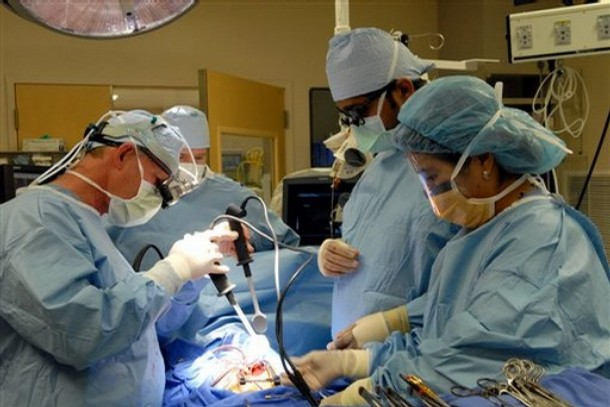“Will The Surgeon ‘Ice’ My Heart During Surgery?” Asks Alma
By Adam Pick on October 17, 2010
I just received an interesting question from Alma about a critical step during heart valve repair and heart valve replacement surgeries. Alma writes, “Adam – I’m going in for surgery next week. Thanks to your book, my anxiety has greatly decreased. I’m curious… I know my heart is going to be cooled and stopped during surgery. But, will my surgeon actually put ice on my bare heart? Alma”
Coincidentally, I just took the picture below while observing a heart valve surgery last week. As you can see, the answer to Alma’s question is typically… Yes.

Ice Chips On Heart During Cooling Process
So you know, the heart is cooled to minimize its metabolic requirements and protect the heart muscle. In addition, a cardioplegia solution (which is a fluid with high concentrations of potassium and magnesium) is introduced to stop the heart completely.
It only takes about 30 seconds for the heart rate to drop to zero. I’ll never forget seeing the heart rate monitor of this patient plummet from 114 to 0 so quickly.
Interestingly, it’s not just the heart that is cooled during open heart surgery, the patient’s entire body is cooled via internal and external techniques. (Side Note: Please make sure to bring a jacket to the operating room if you ever observe a procedure. The operating rooms are quite cold!)

Once the surgeon has completed the heart valve repair or heart valve replacement, the body is warmed and, if needed, the heart is shocked back into rhythm using a defibrillator.
I hope that helps Alma (and perhaps you) learn a little more about how the heart is cooled during open heart surgery.
Keep on tickin!
Adam
|
Maureen Lamarche says on October 17th, 2010 at 11:28 pm |
|
Thank you for this. I’m on a waiting list for AVR and am trying to be patient. I find it hard to sleep at night and it is though a stone or rock settles in my chest as I lie down to sleep. I wonder if anyone else experiences this. |
 |
|
Gianni Rech says on October 18th, 2010 at 2:03 am |
|
Just to add to this info: during my aortic valve replacement in July, apparently the cavaty is also iced, with the result that I was left with diaphragmatic parallesis of the left diaphragm which oviously affects my ability to breath properly. I am told that the diaphrgm muscle will resume functioning but it could take as long as 18 months? Perhaps Adam could comment. Regards and Thx. Gianni |
 |
|
Mary Schrantz says on October 18th, 2010 at 8:48 am |
|
I just asked this question in an appt with a surgeon. He said that they do not cool because they have found the “warming up” portion to increase the incidence of “pump head”, i.e. post-op cognitive difficulties, This hospital lets the temp float at a few degrees below normal, but no temperature intervention. He admitted that cooling probably has some protective effects but that is not worth the warming up liabilities. His team does the mini sternotomy procedure. I asked about the thoracotomy “port” procedure. What is not clear is that the port procedure requires another incision in the groin to attached the lines for the cardiac bypass machine which has inherent risks also. Also much more painful because of all the layers of muscle penetrated between the ribs. So, I went to talk thinking port and came out convinced of mini-sternotomy. Therefore, always ask questions. |
 |
|
Crystal says on October 21st, 2010 at 10:21 pm |
|
I just ordered your book, I am soooo hoping that it will help me to prepare for surgery and help my anxiety and fear. I am a total basketcase, worried about dying and leaving my hubby and kids….Is this normal to feel this way? I am so scared and tired, cant eat a lot just an all around wreck lol…I cant wait to get your book thats for sure! |
 |
|
Giovanni B. Ciuffo, MD says on October 26th, 2010 at 1:39 pm |
|
Mary, Minimally invasive heart surgery through a minithoracotomy can be routinely performed without any additional incisions in the groin or anywhere else. All heart lung connections can be routinely established through the minithoracotomy incision. See pictures of the operation at http://www.bigappleheartsurgery.com/page5.php A good number of heart surgeons have moved away from icing the heart because it can occasionally freeze the phrenic nerves that control our breathing muscle, the diaphragm and cause postoperative respiratory difficulties. The heart is routinely cooled and protected during surgery by injecting cold (4 degrees Celsius)cardioplegic solution in the coronary circulation. As Adam points out the body temperature is controlled by a heat exchanger connected to the heart lung machine. Giovanni B. Ciuffo, MD |
 |












